In Part I and II of this series [1, 2], we presented the data on 400W single ended mogul reflectors, designed primarily to be retrofit into existing canopies, and 250W Double ended reflector fixtures. This article continues in a similar vein and presents the data and analysis of several additional reflectors that we were able to obtain since the last set of tests.
| Reflector | Ballast | Lamp |
|---|---|---|
| PFO Illuminator | Magnetic Ballast (M59) | Ushio 400W 10000K |
| SuperSun IV – Sunlight Supply | Magnetic Ballast (M59) | Ushio 400W 10000K |
| Reef Optix I – Sunlight Supply | Magnetic Ballast (M59) | Ushio 400W 10000K |
| Small Diamond Light | PFO HQI Ballast (M81) | Vion 250W 10000K |
| Regent DIY 150W Double Ended | Reliable Ballast (electronic) | AB 150W 10000K |
| Giesemann 250W Nova II | Giesemann Ballast (electronic) | AB 250W 10000K |
| Giesemann 150W Nova II | Giesemann Ballast (electronic) | AB 150W 10000K |
PFO’s Illuminator and Sunlight Supply’s SuperSun are designed primarily for horticulture use, but given that we tested the Diamond Lighting’s Lumen Arc III which is also a reflector designed for horticulture applications, we felt it would be interesting to test a few other horticulture reflectors. Diamond Light also makes a smaller reflector (called LA3) which is more suited for 250W single ended mogul lamps (it does not accommodate the 400W lamps as they are too long to fit in this reflector). The small Diamond Light reflector’s results are also shown here. Unfortunately, when this reflector was tested the only available 250W lamp on hand was a Vion 250W lamp (not the best lamp in its class and is no longer being sold). So this data cannot be directly compared to the 10000K lamps and reflector systems, however, the % distribution plots of this reflector would provide useful data for comparison purposes.
The two Giesemann Nova II fixtures are also a choice available to the discerning aquarist especially those interested in aesthetically pleasing designs and good quality, and these reflectors are also tested here.
As avid DIY’ers ourselves, we also explored a cheap version of the 150W double ended reflector system made by retrofitting a Regent 500W Halogen lamp fixture. The allure of this fixture is the fact that it can be easily purchased at Lowe’s or Home Depot for about $10, and with a small retrofit of replacing the halogen sockets with the sockets for the 150W double ended lamps, one could make a very cheap reflector for about $20 and change.
The basic methodology and experimental setup is identical to the one used in the previous set of articles (part I and II, references [1] and [2]). The data is also presented in an identical manner with plots for light dispersion for each reflector at distances of 6″, 9″ and 12″ from the center of the lamp. This article is intended to be a continuation of the previous articles and hence should be read in conjunction with the other two articles.
Reflector Data And Analysis
The data plots for each reflector at the distances 6″, 9″, and 12″ are plotted as a surface graph, top view graph, and a % distribution graph to illustrate the intensity and spread at different points on the measuring grid. Table 2 below shows the list of figures associated with each reflector.
| Reflector | Figures |
|---|---|
| PFO Illuminator | Figs. 1-3 |
| SuperSun IV – Sunlight Supply | Figs. 4-6 |
| Reef Optix I – Sunlight Supply | Figs. 7-9 |
| Small Diamond Light | Figs. 10-12 |
| Regent DIY 150W Double Ended | Figs. 13-15 |
| Gieseman 150W Nova II | Figs. 16-18 |
| Gieseman 250W Nova II | Figs. 19-21 |
One of the measures of a reflector performance could be its ability to direct light into the aquarium. A reflector’s total incident light upon a surface of a given area is representative of the performance of a reflector. It is computed by adding up all the measurements taken at the discrete points within the region. It demonstrates how much light the reflector is able to focus downward when compared to other reflectors with similar operating conditions (same ballast and lamp). While it can be argued that adding all the PPFD values is technically not a valid measure as per the definition of PPFD (since PPFD is defined as μEinstein/m2/sec), it can be used to provide a metric for reflector performance. Further summing over the data points on a given area can easily be used to compute the average, if so desired. Since the area under consideration is the same for all reflectors, we can just as well use the sum of the PPFD values distributed over this area (169 data points) instead of an average as a performance metric.
| Reflector: | Distance: | Total Incident Light | Maximum PPFD | ||
|---|---|---|---|---|---|
| 3×3 Area | 2×2 Area | 1×1 Area | |||
| PFO Illuminator | 6″ | 45388 | 43285 | 31140 | 2147 |
| 9″ | 44385 | 37609 | 21809 | 1270 | |
| 12″ | 39631 | 30759 | 14603 | 755 | |
| SuperSun IV – Sunlight Supply | 6″ | 44585 | 43867 | 32103 | 2150 |
| 9″ | 44326 | 39437 | 22892 | 1285 | |
| 12″ | 41449 | 33108 | 16279 | 860 | |
| Reef Optix I – Sunlight Supply | 6″ | 44223 | 42290 | 30168 | 2547 |
| 9″ | 41082 | 35476 | 22486 | 1793 | |
| 12″ | 39887 | 32318 | 18703 | 1317 | |
| Small Diamond Light | 6″ | 27308 | 26700 | 21857 | 1698 |
| 9″ | 24705 | 22616 | 15519 | 1000 | |
| 12″ | 23837 | 20854 | 12185 | 685 | |
| Regent DIY 150W Double Ended | 6″ | 17046 | 17046 | 14985 | 1706 |
| 9″ | 16058 | 16058 | 10854 | 815 | |
| 12″ | 13854 | 13854 | 7717 | 465 | |
| Giesemann 250W Nova II | 6″ | 32085 | 31875 | 28454 | 3360 |
| 9″ | 31479 | 30400 | 20502 | 1513 | |
| 12″ | 30618 | 26931 | 16571 | 887 | |
| Giesemann 150W Nova II | 6″ | 15715 | 15596 | 14048 | 1683 |
| 9″ | 15404 | 14722 | 10159 | 754 | |
| 12″ | 14901 | 12898 | 7144 | 418 | |
As can be seen from this data, the 2 horticulture reflectors (PFO Illuminator and Sunlight Supply’s Super Sun IV) and the Reef Optix are very similar in performance. We have found that reflectors with the ends closed tend to perform better. The Giesemann Nova II fixtures, while very aesthetic and thoroughly designed, could benefit specifically from improved reflector design.
In addition to knowing how much light is incident on a given area, we could also look at how much loss of light occurs on a given area when moving the lamp and reflector higher. Table 4, presents the % of light lost on a specified area as one moves the lamp/reflector from 6″ to 12″ above the surface. A higher % loss would indicate that the reflector is creating a larger spread.
| Reflector | 3×3′ Area | 2×2′ Area | 1×1′ Area |
|---|---|---|---|
| PFO Illuminator | 13 | 30 | 53 |
| SuperSun IV – Sunlight Supply | 7 | 25 | 50 |
| Reef Optix I – Sunlight Supply | 10 | 24 | 38 |
| Small Diamond Light | 13 | 22 | 44 |
| Regent DIY 150W Double Ended | 19 | 19 | 49 |
| Giesemann 250W Nova II | 5 | 16 | 42 |
| Giesemann 150W Nova II | 5 | 50 | 49 |
Another metric to analyze reflector performance could be to determine the area coverage of a specified amount of light. Although it is difficult to determine exactly what this specified minimum PPFD values should be, we have chosen a cut off of 500 PPFD and present the area coverage plots of each of the reflectors in Figures 22,23, and 24.
Conclusion
This article is the 3rd in this series and presents the data and a brief analysis of several additional commercially available reflectors. The data provided shows clearly the differences between the reflectors, and can provide the reader with useful data on the light distribution patterns and shapes, which in turn can be used for purposes of aquascaping and placement of corals.
Acknowledgements
We would like to thank several people whose help made this study possible. They were kind enough to provide us with lamps, reflectors and ballasts for testing: Patrick at PFO Lighting, Brad at Sunlight Supply, Phil at Xenia Inc. for the Giesemann fixtures, Shane Graber for the use of his small diamond light reflector, and Brian at Hellolights.com.
References
- Joshi, S. and Marks, Timothy. 2003. Analyzing Reflectors: Part I – Mogul Reflectors http://www.advancedaquarist.com/2003/3/aafeature
- Joshi, S. and Marks, Timothy. 2003. Analyzing Reflectors: Part II – Mogul Reflectors http://www.advancedaquarist.com/2003/3/aafeature2


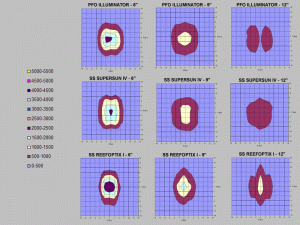
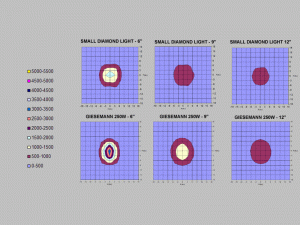
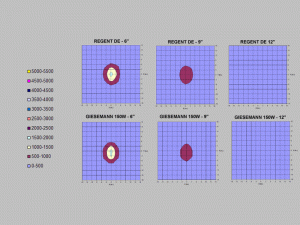
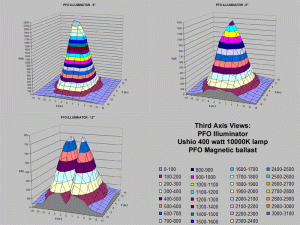
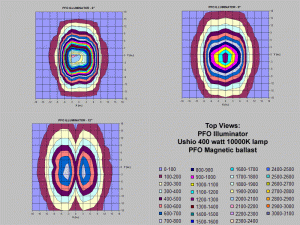
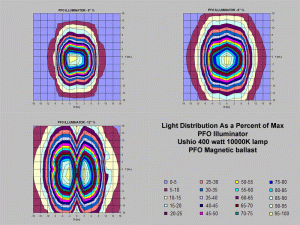
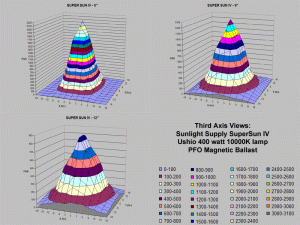
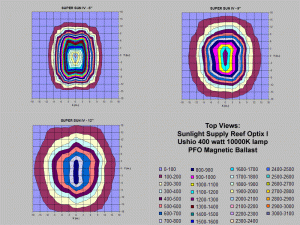
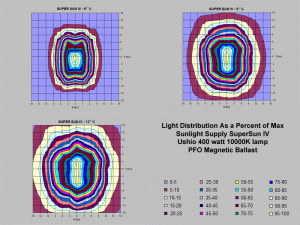
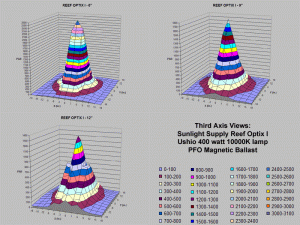
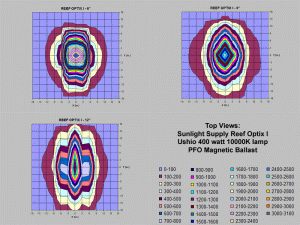
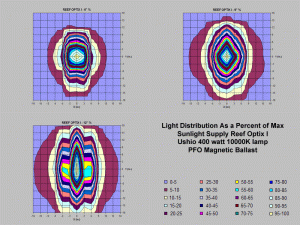
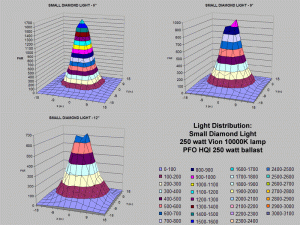
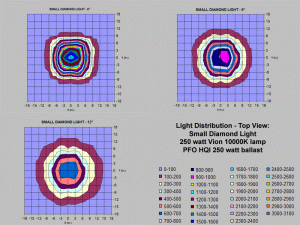
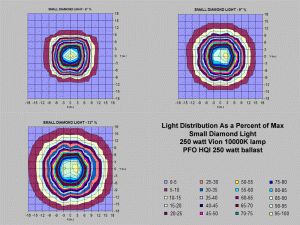
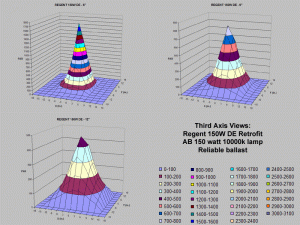
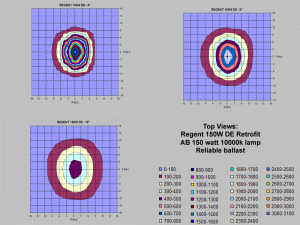
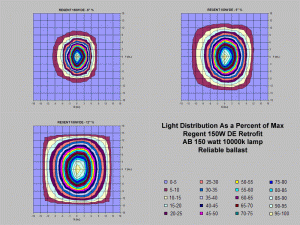
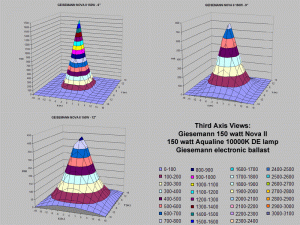
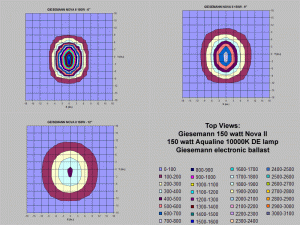
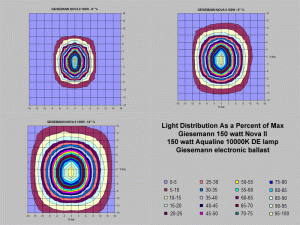
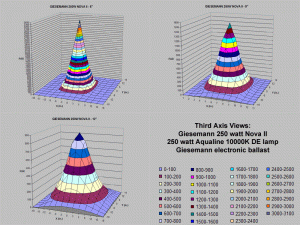
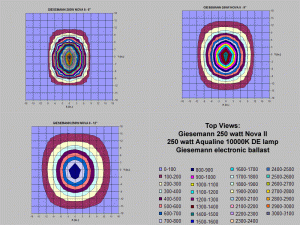
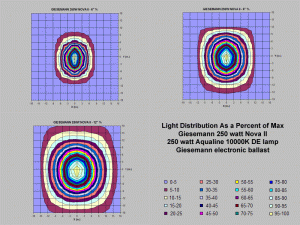

0 Comments